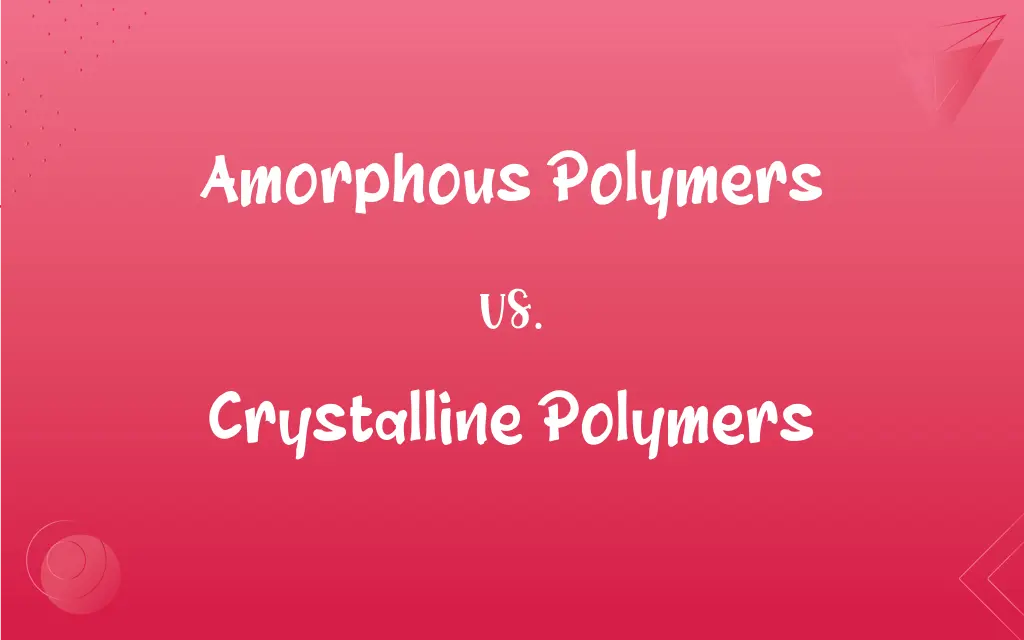Amorphous Polymers vs. Crystalline Polymers: What's the Difference?
Edited by Aimie Carlson || By Harlon Moss || Updated on October 18, 2023
Amorphous polymers lack a regular, ordered structure, while crystalline polymers have a well-defined, repeating arrangement.

Key Differences
Amorphous polymers and crystalline polymers both refer to classes of polymers distinguished by their molecular arrangement and properties.
Amorphous polymers are characterized by their disordered, random molecular structure. This randomness results in them having no clear melting point, but instead, they soften over a range of temperatures. Crystalline polymers, on the other hand, have a more organized and repeating structure. This orderly alignment gives them a sharp melting point, where they transition from a solid to a melt.
When observing both through a microscope, amorphous polymers appear transparent due to their non-uniformity, while crystalline polymers are often opaque because of their well-defined structures. The properties of amorphous polymers and crystalline polymers also differ greatly.
Amorphous polymers tend to be more ductile, softer, and less dense, whereas crystalline polymers are typically harder, more dense, and have greater tensile strength.
While most real-world polymers exhibit a combination of these two structures, known as semi-crystalline, understanding the extremes of amorphous and crystalline provides insight into the behavior and potential applications of different polymer materials.
ADVERTISEMENT
Comparison Chart
Molecular Structure
Disordered and random.
Organized and repeating.
Transparency
Typically transparent.
Often opaque.
Melting Behavior
Soften over a temperature range.
Have a distinct melting point.
Physical Properties
Ductile, softer, less dense.
Harder, more dense, higher tensile strength.
Examples
Polystyrene, Poly(methyl methacrylate).
Polyethylene, Polypropylene.
ADVERTISEMENT
Amorphous Polymers and Crystalline Polymers Definitions
Amorphous Polymers
Tend to be ductile and softer in nature.
Toys made from amorphous polymers can be flexible and bend without breaking.
Crystalline Polymers
Polymers possessing an organized and repeating molecular structure.
Polyethylene, used in plastic bags, is an example of crystalline polymers.
Amorphous Polymers
Typically transparent due to their non-uniform structure.
Clear plastic bottles are often made from amorphous polymers.
Crystalline Polymers
Polymers with a distinct and sharp melting point.
Crystalline polymers like Nylon melt abruptly at a specific temperature.
Amorphous Polymers
Polymers with a random and disordered molecular structure.
Polystyrene is an example of amorphous polymers, often used in packaging.
Crystalline Polymers
Polymers where molecular chains pack in a regular pattern.
The organized structure in crystalline polymers leads to enhanced material strength.
Amorphous Polymers
Polymers with molecules that don't follow a repeating pattern.
The random arrangement of molecules in amorphous polymers contributes to their unique characteristics.
Crystalline Polymers
Characterized by being harder and having higher tensile strength.
Crystalline polymers can be found in applications requiring durability.
Amorphous Polymers
Polymers that soften over a range of temperatures.
Amorphous polymers like PVC become pliable when heated, without a distinct melting point.
Crystalline Polymers
Often appear opaque due to their ordered structure.
The containers made from crystalline polymers aren't typically see-through.
FAQs
How about 'crystalline'? What does it mean?
'Crystalline' polymers have a regular, repeating arrangement in their molecular structures, leading to defined and ordered regions called crystallites.
What are some common examples of amorphous polymers?
Polystyrene, PMMA (poly(methyl methacrylate)), and PVC (polyvinyl chloride) are some examples of amorphous polymers.
What are polymers?
Polymers are large molecules composed of repeating structural units, typically connected by covalent chemical bonds.
What does 'amorphous' mean in the context of polymers?
'Amorphous' refers to polymers that have a disordered, random arrangement of molecular chains with no specific long-range order.
What about crystalline polymers and heat?
Crystalline polymers have a well-defined melting temperature, at which they transition from a solid to a liquid state.
How does processing affect the crystallinity of polymers?
Processing conditions, like cooling rates and molding processes, can affect the degree of crystallinity in polymers, potentially leading to variations in properties.
How do crystalline and amorphous polymers behave under stress?
Amorphous polymers tend to be more ductile and can deform considerably before breaking, whereas crystalline polymers are often more brittle.
And examples of crystalline polymers?
Polyethylene, polypropylene, and polyethylene terephthalate (PET) are crystalline polymers.
How does the transparency of amorphous polymers compare to crystalline polymers?
Amorphous polymers are usually transparent because of their disordered structure, while crystalline polymers are often opaque due to their ordered structures.
How does the mechanical strength compare between the two?
Crystalline regions generally impart greater tensile strength and modulus to polymers compared to amorphous regions.
What role does the molecular weight play in determining crystallinity?
Higher molecular weights often result in increased crystallinity due to the extended chain lengths promoting the formation of ordered structures.
Are there any notable differences in thermal conductivity between the two?
Crystalline polymers generally have higher thermal conductivity than amorphous polymers due to their ordered structures.
Which type of polymer has better resistance to creep (deformation with time under load)?
Crystalline polymers typically exhibit better resistance to creep than amorphous polymers due to their structured nature.
Can a polymer be both amorphous and crystalline?
Yes, many polymers exhibit both amorphous and crystalline regions. Such polymers are termed 'semi-crystalline.'
How do amorphous polymers respond to heat?
Amorphous polymers soften over a wide temperature range and do not have a sharp melting point.
Are crystalline polymers more or less dense than amorphous polymers?
Crystalline polymers are generally denser due to their ordered arrangement.
Can the percentage of crystallinity in a polymer be controlled?
Yes, by controlling factors like polymerization conditions, molecular weight, and processing conditions, one can influence the degree of crystallinity.
Are amorphous polymers more or less resistant to solvents than crystalline polymers?
Amorphous polymers are typically more soluble and swell easily in the presence of solvents, while crystalline regions are less affected by solvents.
How do crystalline and amorphous regions impact barrier properties in polymers?
Crystalline regions typically reduce the permeability of gases and liquids due to their ordered structure, making them better barrier materials than amorphous regions.
How does the chemical resistance compare between amorphous and crystalline polymers?
Crystalline regions in polymers generally offer better resistance to chemicals and degradation than amorphous regions.
About Author
Written by
Harlon MossHarlon is a seasoned quality moderator and accomplished content writer for Difference Wiki. An alumnus of the prestigious University of California, he earned his degree in Computer Science. Leveraging his academic background, Harlon brings a meticulous and informed perspective to his work, ensuring content accuracy and excellence.
Edited by
Aimie CarlsonAimie Carlson, holding a master's degree in English literature, is a fervent English language enthusiast. She lends her writing talents to Difference Wiki, a prominent website that specializes in comparisons, offering readers insightful analyses that both captivate and inform.































































